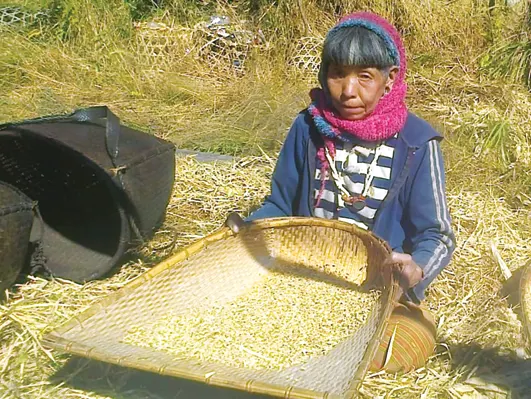The most seasonal agricultural festival of the Idu Mishmi is Keh-Meh-Haa (Keh means rice, Meh means new, and Haa means eating). It is a festival related to the first seasonal harvesting of crops like paddy and various other edible items from the middle of September to October (Puilapu) every year.
Keh Meh Haa is celebrated with religious fervour and traditional gaiety without any differences amongst the living communities. Everyone participates in the festival in their respective village, town, etc. The festival also promotes unity and brotherhood among Kera-ahs, and it offers deities for good harvest, peace and prosperity in every living entity as keh frih, the burning of the first harvest rice, comprehensively followed as a strict eyu ena taboo for a day. Meanwhile, the folks have to abide by the stern instructions which are there by default in the custom sacramental to appease Khinu, Ini Apeh-Milli and Apeh-Gonlo, the main owners, according to the mythology, and the Inyi-Menga-Ah is the ancestor of Kera-ah.
The end of the season pimah simah, probably in October-end (Machi la) or early November (Trangra la), the shifting cultivation starts in the hills fondly known as keh mrah (jhum kheti).
In this case, the primary cultivation area is first cleared of trees, bushes, jungles and vegetation, and then burnt after the ash that remain after burning acts as fertiliser for the soils of jhum land to which an individual belonging to a village or community has a customary right may be community or to that village community as a whole.
Jhum cultivation is several seeds and crops grown as rice, maize, millet, sesame, pumpkins, soybeans, etc. After burning the precise areas and having seasonal or stage-wise crop production and tilling periods during kathu mrah right after the new fire-burning, such as maize, pumpkin, and soybeans, come under the first stage of farming and after a month gap and again starts krawon mrah. Although the essential crop is paddy, the farmers include other crops too, but precisely in the plain areas, wheat is pragmatic for it.
The month of December (Maula pu) up to March (Ena lapu) is the peak time for clearing the bush and grass for paddy (keh) gardening till the end of April or sometime till early May, and all the villagers have to pause a few days for each household to clear all the verdures accordingly, so that every resident or country dweller can grow paddy together.
Throughout the peak seasons, all households come forward for one another and help them clear the meadow before the monsoon rain and later year joint flinch the rice taming. While mass keh akuh haa (eat previous rice) celebration likely commences as a funfair, merrymaking, drinking local rice beer, and eating jungle meat is unambiguously managed as necessary for the big celebration. Apart from neighbouring populaces, passers may join and be part of the month-long festive merriments.
Subsequently, after a gap of four to six months, paddy ripen and is all set to be eaten, and at the same time, the entire villagers came together to yield the rice, and the same fanfare continues till the completion of the harvest – the whole September.
Once reaped, the Keh Meh Haa begins in every household and during the keh frih, the main ritual, before the celebration, some pieces of paddy are burnt in the house to offer the goddess Ini-Apesha and Ini-Apeh Milli, before humans for peace, prosperity and contentment in the community or gratitude ceremonies to the deities for plenteous rice crop in the next seasons.
When jhum cultivation is over, parts of the plot and the land are left and allowed to return to their natural greenery/vegetation. The grower moves to another parcel in the form of shifting cultivation and leaves for the coming groups at intervals of three to four years. A landowner further comes for the same traditional practices which are now hardly seen everywhere, except in interior, rural areas. (The contributor may be contacted at rondoadiju@gmail.com)




